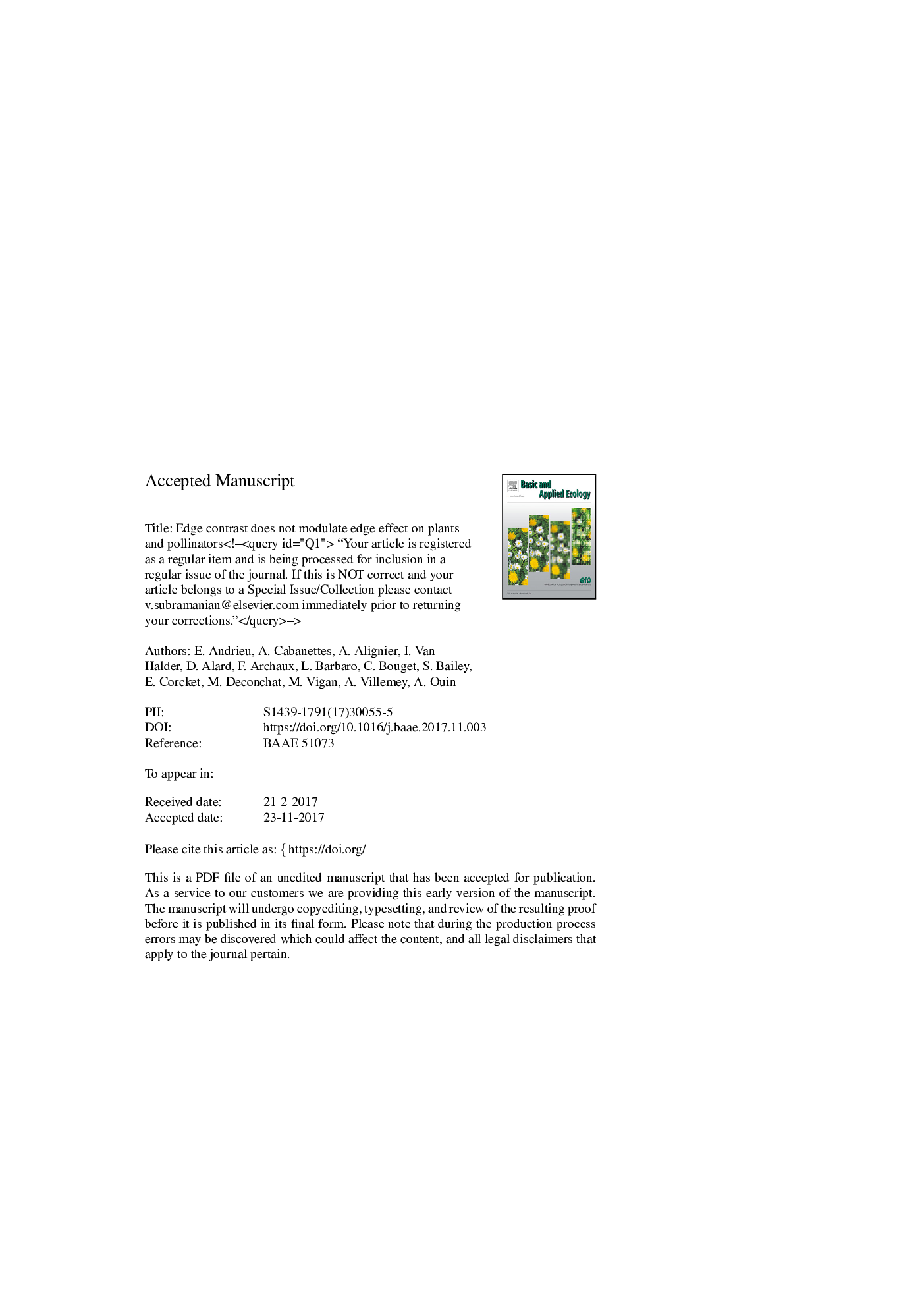| کد مقاله | کد نشریه | سال انتشار | مقاله انگلیسی | نسخه تمام متن |
|---|---|---|---|---|
| 8847031 | 1617854 | 2018 | 30 صفحه PDF | دانلود رایگان |
عنوان انگلیسی مقاله ISI
Edge contrast does not modulate edge effect on plants and pollinators
ترجمه فارسی عنوان
کنتراست لبه، اثر لبه را بر روی گیاهان و گرده افشان ها مدول نمی کند
دانلود مقاله + سفارش ترجمه
دانلود مقاله ISI انگلیسی
رایگان برای ایرانیان
کلمات کلیدی
لبه های جنگل، پروانه ها، زنبور عسل، تنوع بتا، ترکیب منظره، فرانسه،
ترجمه چکیده
کنتراست لبه یکی از عوامل اصلی اثرات لبه است. این تحقیق پاسخ تنوع گیاه و گرده گیاهان (زنبورها و پروانه ها) را به کناره لبه جنگل، یعنی تفاوت میان جنگل ها و زیستگاه های مجاور مجاور با رژیم های مختلف اختلال، بررسی می کند. ما همچنین یک اثر پتانسیل بالقوه ای را از گیاهان به گرده افشیدگی ها بررسی کردیم و اینکه آیا ساختار لبه و ترکیب منظره ارتباط بین لبه کنتراست و تنوع بتا گرده افشان را در بر دارد. 51 نمونه از 51 حاشیه کم کنترلی که در آن جنگل ها در مجاورت زیستگاه ها قرار داشتند نشان دادند که سطح پایین اختلال (مانند تپه های خاکستری، فرسایش خاکی، باغ ها، چمنزارها) و 29 لبه کنتراست بالا وجود داشت که در آن جنگل ها در مجاورت زیستگاه های شدیدتر آتش سوزی، تجاوز به علف های هرز) در سه منطقه فرانسه. ما نشان داد که تنوع گیاهان در لبه ها بیشتر از محیط زیست باز مجاور است، هرچند که در مقابل لبه. با این حال، تنوع گیاه بتا به طور قابل توجهی بین لبه های کم و کنتراست تفاوت نداشت. در حالیکه در مناطق زیستگاه مجاور بیشتر ارگانیسم های گرده افشانی را مشاهده کردیم نسبت به لبه های کنتراست کم، اختلاف معنی داری در تنوع گرده افشانی بتا وجود نداشت. ما یک اثر آبشار از گیاهان به گرده افشانها مشاهده نکردیم. تنوع گیاه و زنبور بتا عمدتا با عوامل محلی (ساختار لبه و پوشش گل) توضیح داده شده است، در حالی که تنوع پروانه بتا با خصوصیات چشم انداز اطراف (نسبت پوشش زمین در چمنزار) توضیح داده شده است.
موضوعات مرتبط
علوم زیستی و بیوفناوری
علوم کشاورزی و بیولوژیک
علوم دامی و جانورشناسی
چکیده انگلیسی
Edge contrast, is one of the main determinants of edge effects. This study examines the response of plant and pollinator diversity (bees and butterflies) to forest edge contrast, i.e. the difference between forests and adjacent open habitats with different disturbance regimes. We also investigated a potential cascading effect from plants to pollinators and whether edge structure and landscape composition mediate the relationship between edge contrast and beta diversity of pollinators. We sampled 51 low-contrast edges where forests were adjacent to habitats showing low levels of disturbance (i.e. grey dunes, mowed fire-breaks, orchards, grasslands) and 29 high-contrast edges where forests were adjacent to more intensively disturbed habitats (i.e. tilled firebreaks, oilseed rape) in three regions of France. We showed that plant diversities were higher in edges than in adjacent open habitat, whatever the edge contrast. However, plant beta diversity did not differ significantly between low and high-contrast edges. While we observed higher pollinator diversities in adjacent habitats than in low-contrast edges, there were no significant differences in pollinator beta diversity depending on edge contrast. We did not observe a cascading effect from plants to pollinators. Plant and bee beta diversities were mainly explained by local factors (edge structure and flower cover) while butterfly beta diversity was explained by surrounding landscape characteristics (proportion of land cover in grassland).
ناشر
Database: Elsevier - ScienceDirect (ساینس دایرکت)
Journal: Basic and Applied Ecology - Volume 27, March 2018, Pages 83-95
Journal: Basic and Applied Ecology - Volume 27, March 2018, Pages 83-95
نویسندگان
E. Andrieu, A. Cabanettes, A. Alignier, I. Van Halder, D. Alard, F. Archaux, L. Barbaro, C. Bouget, S. Bailey, E. Corcket, M. Deconchat, M. Vigan, A. Villemey, A. Ouin,
